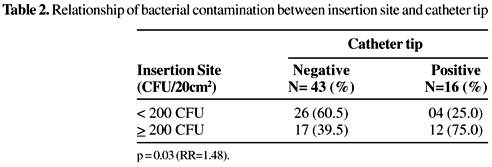Bacterial counts were made of catheter insertion site and of catheter tips to help determine risk factors associated with catheterization of the jugular and subclavian veins. Among the 116 patients included in this study, 69% had central venous catheters (CVC) in the subclavian vein. Seven or more days catheterization (p=0.001) and >3 invasive devices (p=0.01) were infection risk factors associated with catheterization of the jugular vein. More than half of the patients presented high colony counts at the insertion site (>200 CFU/20 cm²) and 27% of the catheter tips were contaminated. The risk factors associated with contaminated catheter tips were >14 days hospital stay (p=0.02), >7 days catheterization (p=0.01) and antibiotic therapy (p=0.04). Coagulase-negative staphylococci (CoNS) and Staphylococcus aureus were the most common microorganisms at the insertion site (78%) and in the catheter tip (94%). Five patients presented sepsis (4.1%), four caused by Staphylococci and one by GNB. Twelve patients had the same microorganisms at the insertion site and catheter tip. We found a high prevalence of ORSA (62.5%) and ORCoNS (57.1%) in catheter tips. The high counts of staphylococci, including ORSA and ORCoNS, at the insertion site, and the significant association of this colonization with catheter tip contamination, indicate that the skin is an important reservoir of microorganisms associated with catheter-related bloodstream infection (CR-BSI). Health professionals should be aware of this potential source of infection at the CVC insertion site.
CVC; risk factor; CR-BSI; ORSA; ORCoNS





